Did you know harsh chemical disinfectants can leave harmful residues? Discover safe, natural ways to disinfect the kitchen effectively, ensuring food safety and a clean kitchen that protects your family’s health. In this comprehensive guide, you'll learn practical, gentle methods that protect both your home and the environment, so you can maintain a sparkling clean kitchen—without compromise.
Why Choose Natural Methods to Disinfect the Kitchen?

Potential risks of harsh chemical disinfectants—impact on health and kitchen surfaces: Many commercial kitchen cleaning products include bleach, ammonia, or other harsh chemicals that can irritate skin, eyes, or respiratory systems, making natural alternatives safer for your kitchen. These substances may also corrode kitchen surfaces or damage kitchen towels, stainless steel appliances, and countertops over time. Even after wiping kitchen surfaces, harsh chemicals may leave residues that remain on surfaces and could pose risks if ingested, especially for children or pets who touch or eat food directly off kitchen counters or tables.
Environmental benefits of gentle, natural cleaning solutions for cleaning the kitchen: Eco-friendly alternatives like vinegar, baking soda, and lemon minimize harmful impact on waterways and the broader environment. Choosing reusable kitchen towels or switching from disposable paper towel to washable cloths further reduces waste associated with cleaning the kitchen. By opting for natural methods, you contribute to a healthier planet and create a more sustainable, resource-conscious kitchen.
"Harsh disinfectants may leave residues you can ingest. Opting for natural alternatives ensures a safer kitchen for your family." – Food Safety Expert
What You'll Learn in This Guide to Disinfect the Kitchen
The safest ways to clean and sanitize kitchen sinks, countertops, and utensils
Step-by-step methods to disinfect the kitchen using non-toxic products
Tips for maintaining food safety and a clean kitchen with natural solutions
Understanding the Importance of Food Safety and Disinfecting the Kitchen
How germs and bacteria spread in the home kitchen: The kitchen is the heart of the home—and also a hotspot for harmful bacteria. Germs can transfer from raw meat, food waste, dirty dish piles, and unwashed hands. Bacteria often remain on surfaces like the kitchen sink, cutting boards, and countertops long after food is prepared. Cross-contamination between food prep zones and dishes and utensils increases risk, especially if you don’t clean and sanitize thoroughly after handling raw meat or eggs.
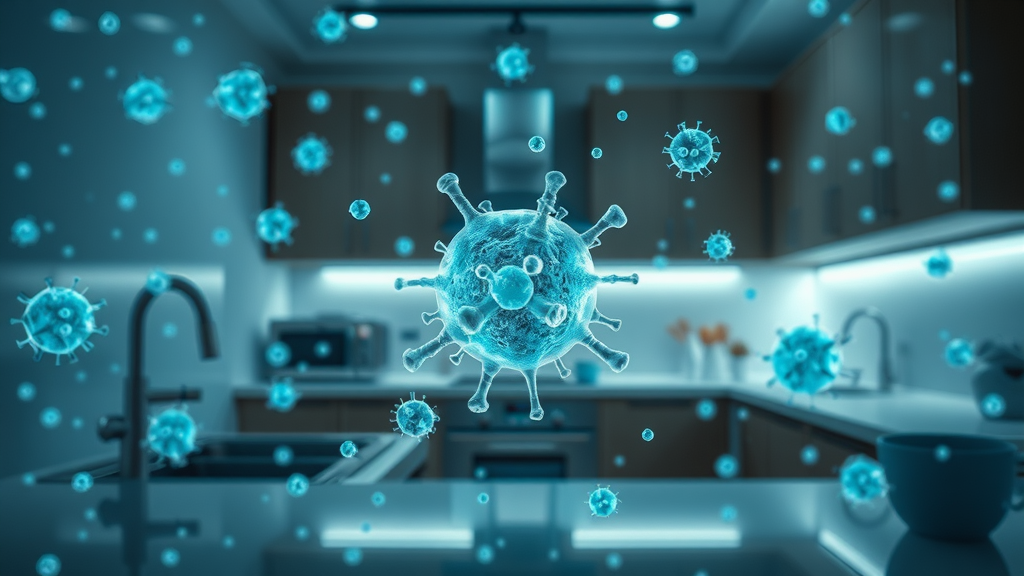
The role of regular disinfecting in food safety: Keeping a clean kitchen isn’t just about appearances—it’s essential for food safety and preventing harmful bacteria in your home. Regular kitchen cleaning and sanitizing routines destroy or remove germs that could cause foodborne illness. When you disinfect the kitchen regularly using natural products, you minimize exposure to these invisible threats, protecting your family from foodborne illnesses that can result from neglecting routine kitchen surface care.
"Proper disinfection reduces the risk of foodborne illness. Prioritize consistent kitchen cleaning and sanitizing routines." – Kitchen Pro Hygiene Specialist
Essential Tools and Natural Products to Disinfect the Kitchen
Vinegar, baking soda, hydrogen peroxide, and lemon as natural disinfectants: White vinegar effectively breaks down food waste, soap scum, and grime on kitchen surfaces. Baking soda acts as a powerful gentle scrub for the kitchen sink and more, while hydrogen peroxide can safely sanitize without residue. Lemon's citric acid fights odors and bacteria, making it valuable for both cleaning and freshening air.
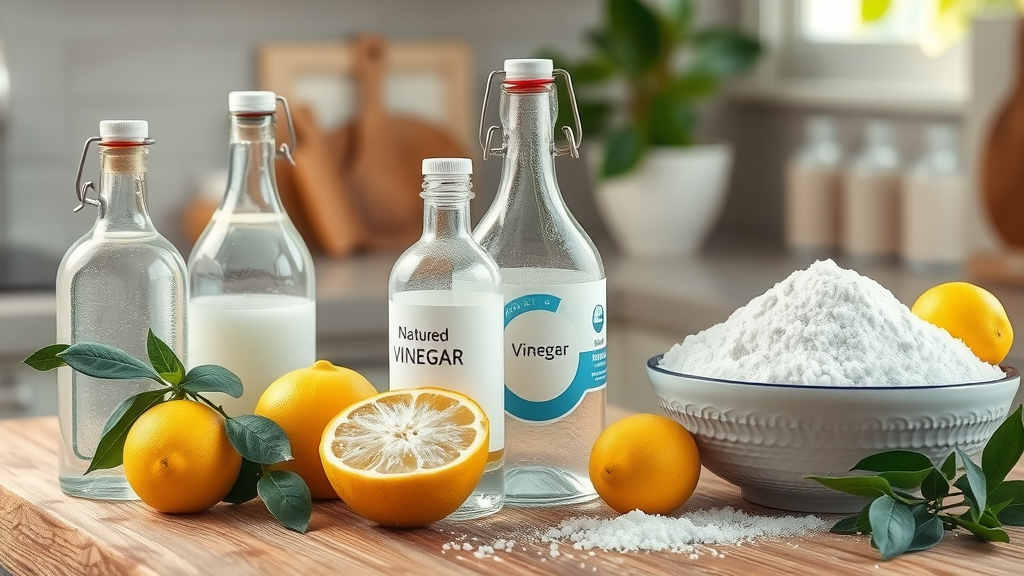
Best reusable and eco-friendly kitchen towels for clean kitchen surfaces: Replace single-use paper towel with thick, absorbent kitchen towels or microfiber cloths to reduce waste and maintain a clean kitchen. These can be washed and reused hundreds of times, reducing waste and providing excellent dirt and bacteria removal for a clean kitchen.
Choosing the right kitchen towel and microfiber cloths: For best results, designate separate towels for drying dishes and for wiping kitchen surfaces to prevent the spread of bacteria. Look for lint-free, quick-drying options to keep your kitchen towel collection clean and ready for any task.
Cleaner |
Effectiveness |
Safety |
Cost |
|---|---|---|---|
Natural Vinegar/Lemon/Baking Soda |
Kills many common germs; breaks down grime |
Non-toxic, safe for most kitchen surfaces |
Very affordable |
Hydrogen Peroxide |
Effective against bacteria, viruses, and mold |
Safe when handled correctly; non-residual |
Low cost |
Chemical Cleaners (Bleach, Ammonia) |
Broad-spectrum bacterial/viral kill |
Toxic fumes, residue; potentially damaging |
Varies (usually higher) |
Among the natural options discussed, baking soda stands out for its versatility and health benefits. If you're interested in learning more about how baking soda can positively impact your well-being beyond cleaning, explore these surprising health benefits and uses of baking soda for a holistic approach to a healthier home.
Step-by-Step: How to Disinfect the Kitchen Sink Safely
Pre-cleaning: Removing food debris from the kitchen sink: Before disinfecting, clear the sink of any dirty dish residue and food scraps. Use a kitchen towel or paper towel to collect and discard remaining debris, then rinse the sink basin thoroughly with warm soapy water. This crucial initial step prevents food waste from spreading bacteria and makes disinfection more effective.
Applying natural disinfectants to the kitchen sink and faucet: Sprinkle baking soda across the kitchen sink and gently scrub with a damp sponge to clean and sanitize naturally. For stubborn stains or odors, pour vinegar—especially around the faucet and drain. Let the mixture fizz for several minutes, then rinse thoroughly. For added germ-fighting, spray hydrogen peroxide or rub cut lemon halves across stainless steel faucets for sparkling, residue-free surfaces. Rinse and air dry or pat dry with a fresh, clean kitchen towel.
How to clean and sanitize the garbage disposal and kitchen drains: Drop lemon slices, ice cubes, or a tablespoon of baking soda into the disposal, then run it with cold water. For deeper cleaning, swirl a cup of vinegar down the drain and let it sit before rinsing with hot water. This helps break down food waste build-up and neutralize odors, keeping bacteria at bay.

"The kitchen sink harbors more bacteria than many realize. Natural cleaning agents can be just as effective as harsh chemicals." – Kitchen Cleaning Pro
How to Clean and Sanitize Kitchen Surfaces Without Chemicals
Gentle scrubbing techniques for countertops, cutting boards, and appliances: For non-porous countertops and kitchen surfaces, sprinkle baking soda, then dampen with a vinegar-water solution or rub with lemon juice. Scrub gently with a microfiber kitchen towel or dedicated sponge. For wooden cutting boards, use coarse salt and lemon to remove embedded food waste and odors.
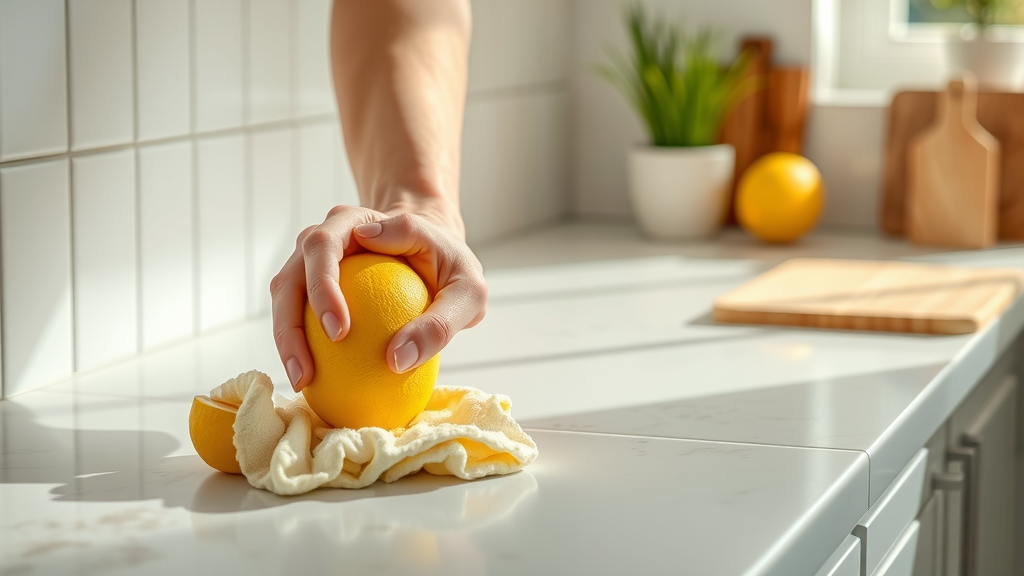
Using kitchen towels and microfiber cloths for best results: Wipe down every kitchen surface, including appliances and the kitchen sink rims, with clean, damp kitchen towels or microfiber cloths for effective cleaning. Rinse towels frequently and replace with fresh kitchen towels as needed to prevent the spread of bacteria.
Food safety tips when cleaning kitchen preparation zones: Always clean and dry food prep zones immediately after handling raw meat or eggs. Use separate towels and keep paper towels handy for high-risk messes to reduce risks of cross-contamination and foodborne illness. Never let wet or dirty towels pile up; wash them in your washing machine after each day to stay ahead of germs.
Natural Solutions to Disinfect High-Touch Areas in the Kitchen
Handles, switches, and knobs: Application tips for safe kitchen disinfection: High-touch areas such as refrigerator handles, cabinet knobs, and light switches require regular disinfecting to maintain a clean kitchen and ensure food safety. Spray or wipe these areas with a vinegar-water solution, then immediately follow with a clean kitchen towel or cloth for extra removal of germs and residue. Hydrogen peroxide is also excellent for disinfecting stainless steel surfaces without leaving streaks or lingering fumes.
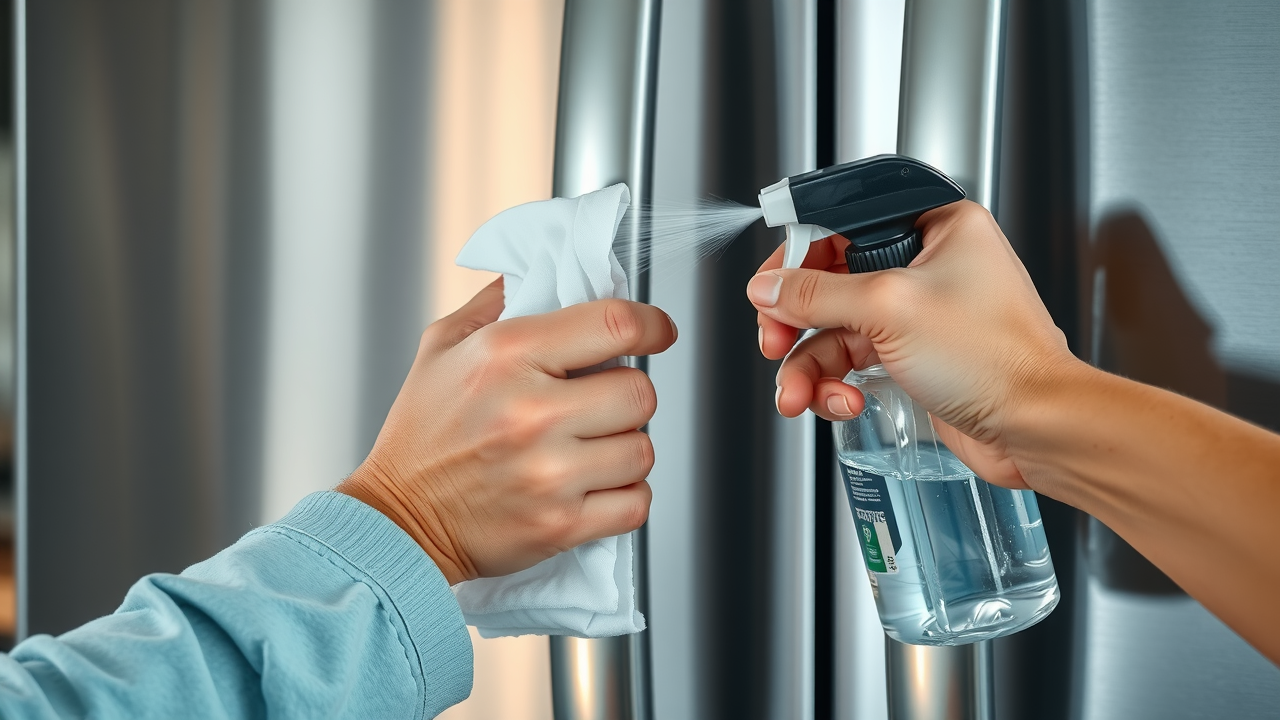
Keeping kitchen towels, sponges, and cloths germ-free: Regularly disinfect the kitchen sponges and towels by soaking them in boiling water, running them through a hot wash cycle in the washing machine, or microwaving (only if damp and microwave safe). Air dry fully to curb bacteria regrowth, and rotate fresh towels into use daily to maintain a clean kitchen.
Kitchen Pro Tips: Prevent Cross-Contamination While Disinfecting the Kitchen
Proper handwashing techniques before and after cleaning the kitchen: Always start with a thorough hand wash—scrub using soap and water for at least 20 seconds to maintain kitchen pro hygiene standards before and after cleaning. After you disinfect the kitchen, wash hands again, especially after handling dirty dish towels, raw meat, or chemical-free cleaning agents.

How to use separate kitchen towels and cloths for different cleaning zones: Designate one kitchen towel for drying dishes, another for wiping counters, and a third for appliances or the floor. Color-coding or labeling towels helps prevent the spread of bacteria and ensures each area is cleaned with the right tool.
Smart storage of cleaning supplies to maintain a clean kitchen: Store all-natural, child-safe cleaning agents away from food prep areas but within easy reach. Keep towels dry and kitchen cleaning products organized in labeled bins or caddies to avoid confusion and encourage a routine cleaning habit.
"Always use fresh kitchen towels on surfaces used for food preparation to avoid reintroducing bacteria." – Kitchen Safety Advisor
Eco-Friendly Practices to Disinfect the Kitchen for Lasting Food Safety
Recycling old kitchen towels and minimizing single-use products: Give old kitchen towels new life by repurposing them as reusable cleaning cloths or rags. Avoid paper towel overuse—switch to washable alternatives for wiping kitchen surfaces and drying dishes, slashing both cost and landfill waste.
Making your own all-natural kitchen disinfectant spray: Combine 1 part white vinegar, 1 part water, and several drops of lemon juice or your favorite natural oil in a spray bottle. This simple homemade cleaner is perfect for daily kitchen cleaning and safe on most kitchen surfaces.
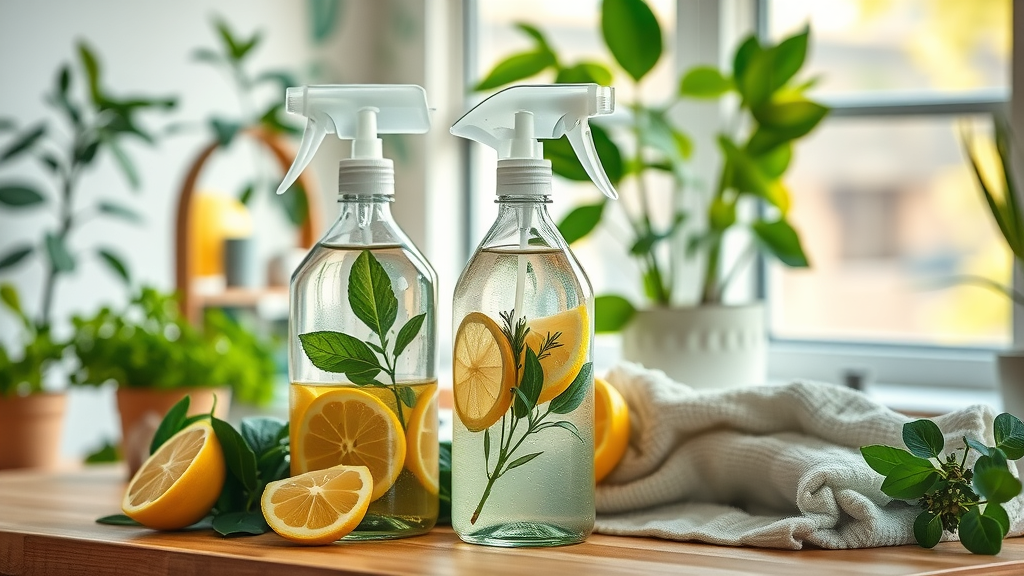
Green alternatives for odor control and freshening: Place small bowls of baking soda in the fridge or pantry to absorb lingering odors, and simmer citrus peels or herbs on the stove to freshen the air naturally. These easy solutions maintain a clean kitchen atmosphere without introducing toxins.
Frequently Asked Questions: How to Disinfect the Kitchen Naturally
Which natural ingredients are most effective for kitchen disinfecting?
Vinegar, baking soda, lemon juice, and hydrogen peroxide are the most powerful, widely available natural disinfectants for kitchen use. Each tackles bacteria, food waste, and odors without introducing chemicals harmful to your family or kitchen surfaces.Are natural kitchen disinfectants as effective as chemicals?
When used correctly and regularly, these solutions perform impressively against everyday germs, especially when paired with proper kitchen cleaning techniques like scrubbing and air drying. While not always as broad-spectrum as industrial cleaners, they provide high food safety levels when paired with best practices.How often should I disinfect the kitchen for optimal food safety?
Wipe surfaces, handles, and the kitchen sink daily and ramp up kitchen cleaning after handling raw meat or during high-use food prep. Deep clean and sanitize the kitchen weekly, including hidden spots like the garbage disposal and pantry shelves, to prevent the spread of bacteria and foodborne illness.
People Also Ask: How to Disinfect the Kitchen and Ensure Food Safety
How to properly disinfect a kitchen?
The best way to disinfect the kitchen starts with daily cleaning using safe natural cleaning products, like vinegar or lemon solutions, to clean kitchen surfaces. Use clean kitchen towels for each different area: one for countertops, one for dishes and utensils, and another for the kitchen sink. Scrub food prep zones thoroughly, rinse with soapy water, and air dry or dry with a sterile towel. Always wash your hands before and after kitchen cleaning to prevent the spread of bacteria.
What is the best disinfectant to use in the kitchen?
While chemical disinfectants remove a broad spectrum of bacteria, a mixture of vinegar and water, or hydrogen peroxide, is highly effective for most kitchen applications. Lemon juice is ideal for deodorizing and enhancing food safety, and baking soda offers deep-cleaning, gentle abrasiveness. For stainless steel or sensitive surfaces, commercial eco-friendly cleaners are available as natural alternatives.
What kills bacteria in the kitchen?
Natural acids in vinegar and lemon break down and destroy bacteria, while hydrogen peroxide oxidizes and neutralizes pathogens. Soap and water physically remove harmful bacteria from kitchen surfaces, cutting boards, and kitchen sinks, making regular cleaning and sanitizing critical for keeping your kitchen the heart of the home—and safely so.
How often should you disinfect your kitchen?
Wipe and disinfect kitchen countertops, kitchen sink, and high-touch handles daily—preferably after preparing raw meat or handling food waste to ensure food safety. Weekly, deep clean areas like your garbage disposal, fridge handles, and appliance knobs. Regular routines ensure food safety and protect your family from foodborne illnesses.
Key Takeaways: Disinfect the Kitchen Without Harsh Chemicals
Natural ingredients provide effective, safer options to disinfect the kitchen
Regular cleaning and sanitizing routines help ensure kitchen and food safety
Eco-friendly practices reduce harm to your family and the environment
Conclusion: Make the Switch—Disinfect the Kitchen Naturally Today

You don’t have to rely on harsh chemicals to keep your kitchen sparkling, nor risk your family’s health. Try these proven, natural solutions to disinfect the kitchen and maintain a clean kitchen environment that supports food safety.
Ready to transform your home? Get started with natural kitchen disinfecting today and enjoy peace of mind with every meal.
Maintaining a naturally clean kitchen is a powerful step toward safeguarding your family's health, but it's also important to stay informed about potential food safety risks. For a deeper look at how contamination can impact everyday foods, discover the latest on recent food recalls and contamination issues, such as cleaning solution found in liquid eggs. Expanding your knowledge on these topics empowers you to make smarter choices in the kitchen and beyond, ensuring your home remains a safe haven for everyone at the table.
Sources
To enhance your understanding of natural kitchen disinfection methods, consider exploring the following resources:
The Centers for Disease Control and Prevention (CDC) provides comprehensive guidelines on “When and How to Clean and Disinfect Your Home,” emphasizing the importance of regular cleaning and the use of appropriate products to maintain a healthy environment. (cdc.gov)
The University of Nebraska-Lincoln offers insights into “Eight Everyday Kitchen Surfaces to Clean and Disinfect,” highlighting often-overlooked areas that require attention to prevent the spread of germs. (food.unl.edu)
These resources offer valuable information on effective and safe cleaning practices, helping you maintain a hygienic kitchen environment without relying on harsh chemicals.
 Add Row
Add Row  Add
Add 




Write A Comment